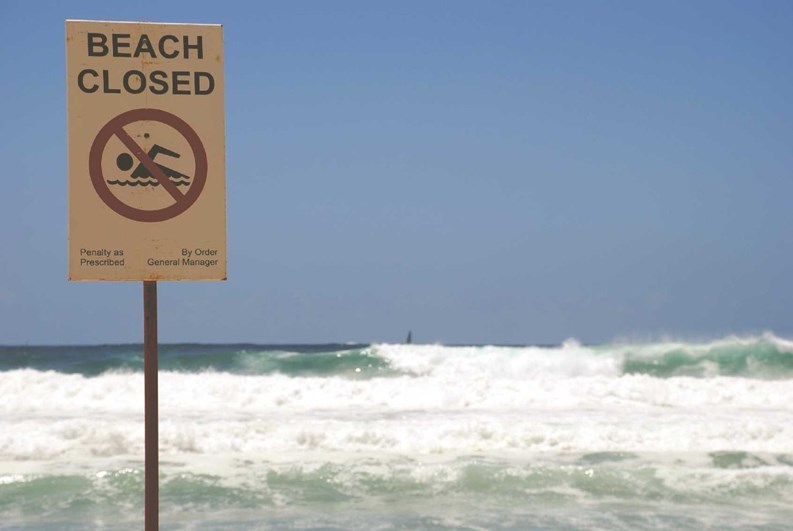With more than 8,000 miles of shoreline and 1,300 miles of sand, Florida is a beach lover’s paradise. From the sugar-white expanses of the panhandle to the shell-lined sands of Sanibel and the rocky coastal beaches of the Keys, you are never more than 60 miles from a beach in Florida. Three of America’s top ten beaches are located in the Sunshine State, and visitors from all over the world make Florida beaches an annual destination—over 75 million of them on average.
Beach Rights
The only thing better than visiting a Florida beach might be living on one. A large segment of Florida’s 18.8 million population has the ocean as a front yard. But is that front yard private? Who owns the beach access, and who is responsible for the safety and privacy of the residents and/or guests?
In a 1999 issue of the Journal of Land & Environmental Law by S. Brent Spain, the topic of beach access is discussed at length as it pertains to an earlier lawsuit. In the 1974 case, City of Daytona v. Tona-Rama, Inc., the Florida Supreme Court recognized the doctrine of “custom” as the means to establish public rights to dry sand areas for traditional recreational use.
It was argued that in the absence of state legislation adequately preserving beach access for the public, local government should be responsible for ordinances protecting the public’s customary right to use the dry sand areas of the beach. It literally comes down to a line in the sand as Florida recognizes the mean high water line as the acceptable boundary between public trust land and private property. While the mean high water line is an ever changing and fictional line, it is recognized as a legal point of demarcation. If the public has customarily had access to the beach area, then that access must be recognized and taken into account when changes and developments are proposed and executed.
The developer is mandated with maintaining perpendicular access for the public, or the access from the roadway to the public segment of the beach. Horizontal access refers to the public’s right to walk along the beach below, or parallel to the mean high-tide line. Wet sand beach area below the mean high water line, is held by the state and therefore in trust for all.
Managing Access & Safety
Above the mean high water line, dry sand is often private property. As noted in City of Daytona v. Tona-Rama, Inc., “Florida cities continue to struggle with balancing the tension between the rights of private beachfront landowners to exclude persons from their property and the rights of the public to utilize the dry sand areas of Florida beaches.”
Florida is one of the more aggressive states requiring a comprehensive plan and a consistency doctrine to govern beach access by the public. Florida’s Local Government Comprehensive Planning and Land Development Regulation Act requires the adoption of local plans with both mandatory and discretionary elements.
Property management companies working with beachfront condominiums and co-ops should be well aware of local comprehensive plans. HOA‘s and COA’s board members and residents should also be well schooled in the local rules and regulations governing access to the property they call home. The ideal time for a resident to learn the local plans and regulations is of course prior to purchasing property. but staying up to date on changes or modifications to existing laws should be an ongoing activity for board members and residents alike. State and local government agencies are also great resources for associations to both educate and protect residents.
The Healthy Beaches Program (HBP) at Florida Department of Health (FDOH) monitors water quality weekly at beaches in 34 Florida counties as part of the DOH Beach Water Quality Program. Additional websites pertaining to water safety are available statewide and include the EPA Beaches Programs, the Florida Department of Environmental Protection, the Coastal Management Program and the Surfrider Foundation.
Beach Safety Director Gary Wise is well aware of beach access concerns and the mean high tide line. He has spent the last six years supervising safety issues for the guest and residents of Santa Rosa Beach, in the South Walton Fire District in Florida’s panhandle. Wise works closely with Fire Marshal Samuel Sanchez. Beach lifeguards are hired through the Tourist Development Council and Sanchez has been successful in securing that bid over the last several years. Lifeguard locations and times are posted on the South Walton Beach Safety website with a thoughtful suggestion “know before you go.” Both Wise and Sanchez are a resource for this local beach community. Every area should have similar professionals.
In addition to guards, Wise uses a flag warning system, also displayed on the website with an eye towards educating everyone on the possible dangers unseen in the surf. “There is no perfect system,” he states. But he keeps the flags flying 24/7 whether a lifeguard is present or not. Flag colors, size and display procedures are universal in Florida in order to inform without confusion. The flag system is used to notify the public when the water is closed due to high tides or currents, dangerous marine life or bacteria, or any other unsafe condition.
Education is Key
Wise has a three-pronged approach to safety with education being the first component. ‘Most people do not know their own limitations,” he cautions. “Even moderate surf can overpower someone that is not a strong swimmer.” The second safety component is prevention, if there is a problem remove it, or move the individual to safety, and finally response or intervention when needed to prevent injury or loss of life.
Rip currents are probably the least understood danger. “Ninety-five percent of the population could not identify a rip current from the shore,” says Wise. “It is usually the good Samaritan who tries to save another swimmer that is lost,” he explains. A list of characteristics common to rip currents is also posted on the South Walton Beach Safety website. In addition to the website, Santa Rosa Beach also has a Facebook page.
Many beach communities, particularly those appealing to tourists will also have websites and social media outlets to help keep residents and visitors informed of activities and safety concerns.
Decisions on who is best qualified to care for beachfront property will be a major concern for associations. A well-qualified property management firm can provide education and experience for the board, and a risk management professional can provide expertise in reducing exposures and liabilities. Boards that decide to self-manage may choose to use these professionals in a consulting capacity. Likewise, if the decision is to perform all maintenance with property staff, be sure sufficient coverage is in place both for the staff and the association board.
Jeff Hanneken, vice president at Paragon Risk Management, usually recommends a property survey with prospective clients. “It is important to have the proper discussions,” he counsels. “Where does your property start and stop, where is there overlap?” Hanneken’s firm specializes in COA risk management. “There is no real template for beachfront property, each must be considered case by case.” In addition to the expertise he brings to the table, many of the properties he services also have attorneys readily accessible. “Good agents and professionals can guide a board in minimizing risk and exposures.”
If a subcontractor is brought on board, it is important to have full disclosure concerning licensing, insurance and necessary bonds. Will they lighten the management load or add to the financial exposure in the event of an accident, injury or property damage? Are lifeguards provided by the community or is the beach unguarded and does that add or subtract to possible liabilities?
Hanneken always looks at the overall exposure a property might face in a worst case scenario. “Don’t forget about property damage in addition to liability coverage. If you have beach umbrellas, tables and chairs in a common area, and they are stolen or damaged, it can result in a costly replacement expense.”
He is also a big proponent of signage. “Good lighting and well placed and informative signs can go a long way towards reducing risk for residents, guests and staff.” Signage is also a way of showing the intent to protect and inform anyone living, working or visiting on the property. It is also one of the least expensive measures a board can take to protect against an exposure.
Finally with any beachfront property the question arises about the possibility of securing the property perimeters with fencing. When fencing is an option, it is a great one. As long as public access to the beach is not blocked, a fence can separate the property from the general public and create a barrier to unwanted foot traffic. It can also enhance the area and add to the overall property value or perception of value.
When all safety and exposure concerns are adequately addressed and covered a day at the beach is a relaxing Florida lifestyle for everyone concerned.
Anne Childers is a freelance writer and a frequent contributor to The South Florida Cooperator.







Leave a Comment